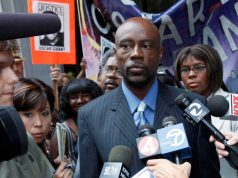
(6/28) — 20:18 PDT — LOS ANGELES — An expert witness retained by the defense for Johannes Mehserle, the former BART Police officer charged with murder in the shooting death of unarmed passenger Oscar Grant, said today that he had no doubt that Mehserle would have been justified in Tasing Grant because he was resisting being handcuffed.
But during a rough cross-examination, retired LAPD Captain Greg Meyer, a police trainer who is an expert on Tasers and use of force by police officers, revealed a seeming lack of familiarity with the details of the case.
Under questioning by defense attorney Michael Rains, Meyer said Grant was a resisting arrest in a manner serious enough to justify Taser use by Mehserle.
“It’s very clear to me that Mr. Grant was resisting arrest,” Meyer said. “Regardless of what anyone says, I can see it [on video footage of the incident] with my own eyes.”
Meyer said that he thought the video footage showed Grant intentionally holding his right arm under his body to prevent officers from handcuffing him.
Meyer said it would have been appropriate for officers to punch, kick, use pepper spray, or wield a baton to subdue Grant, though he said using a Taser would be preferred over any of those alternatives because it would be less likely to “inflame the passions” of bystanders.
Meyer also said former BART Police Officer Anthony Pirone was within his rights to order the arrest of Grant minutes before the shooting, citing Grant’s re-boarding the BART train to evade an officer and his standing up from the seated position he had taken on the platform.
“Either of those things alone is sufficient to violate 148,” he said, referring to the section of the California Penal Code defining the crime of obstructing a police officer.
Meyer later testified that he didn’t “see anything where [Pirone] was clearly over the line” in his use of force while reviewing video footage of the incident taken by BART passengers.
Meyer also testified Mehserle’s Taser training was inadequate.
“It could have been better. It had some deficiencies,” he said.
He said the training the ex-officer received from BART was “more of an introductory practice,” and “not the type of training that would cause muscle memory to occur.”
But during a lengthy cross-examination, Alameda County Deputy District Attorney David Stein sought to cast doubt on Meyer’s objectivity and his testimony.
Meyer has previously testified in more than 50 cases, and although he remembered testifying against officers on occasion, “in many more I’ve defended officers,” he said.
Stein revealed that Meyer testified several times in the trial of the four police officers caught on videotape beating Rodney King. Meyer said today under questioning by Stein that he did not believe those officers used excessive force.
Pressed by Stein, Meyer said that to take someone into custody for simply standing up while detained would be “kind of a cheap arrest,” although technically legal.
Meyer admitted that he had formed his opinion on Mehserle’s case in March 2009, before the completion of either BART’s internal investigation into the incident or an independent review conducted by law firm Meyers Nave.
Meyer said that he had not reviewed any of the depositions taken from witnesses on the train or the platform, or the transcripts from the preliminary hearing which determined that there was sufficient evidence to try Mehserle for murder.
Meyer was unable to recognize the name of the operator of the train stopped at the platform during the incident, Keecha Williams, and that of another eyewitness who has taken the stand in the case. For those whose names he recognized, he could not say whether they were on the train or the platform that night.
By way of contrast, Stein read from one of Meyer’s publications where he stated that all his years in police work caused him “never to form opinions before reviewing all the evidence” in a case.
Meyer also incorrectly referred to Grant as “the defendant” in the trial at least twice during his testimony.
Both Rains and Stein had Meyer address six prior cases nationwide where officers mistakenly drew firearms instead of Tasers.
In each of those cases, the Taser was holstered so the officer’s dominant hand would draw it, and a single shot was fired as opposed to the two or three rounds that are customary when using lethal force.
Mehserle’s Taser was set up for a draw with his dominant hand, and he fired a single shot into Grant’s back. The defense contends that the shooting was accidental and that Mehserle, 28, meant to draw his Taser instead of his gun.
But Stein pointed out that, unlike the officers in the other incidents, Mehserle was wearing his Taser on the side of his body opposite his gun, and also highlighted the fact that Mehserle did not tell anyone at the time that he had drawn his gun by mistake.
In the other cases, the officers who accidentally fired immediately and repeatedly said that they had made a grave mistake. Stein said that one officer yelled something to the effect of “Oh my god, I put the f– Taser on the wrong side!” before breaking down in tears, and that another repeated “Oh my god” before saying “I really screwed up” and later told his colleagues “I’m sorry I ruined the Tasers for you guys.”
None of the six other cases discussed led to a murder charge.
A defense expert on how police officers respond to stressful situations, Minnesota State University Professor William Lewinski, followed Meyer onto the witness stand in the afternoon. Lewinski’s testimony will continue Tuesday in Los Angeles, where the case has been moved over concerns that Mehserle could not receive a fair trial in the Bay Area.
The California Beat and The Campanil’s joint continuing coverage of the Johannes Mehserle BART Shooting trial is funded in part through Spot.Us. Visit our special trial news page and help fund this project.
Beat reporter Tashina Manyak reported from Los Angeles. Contact Tashina Manyak at tmanyak@californiabeat.org.









